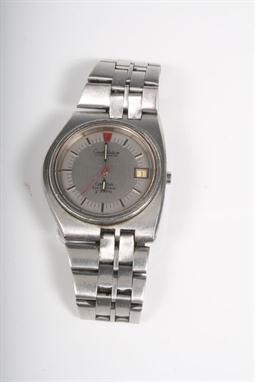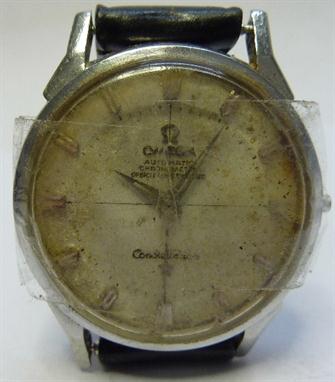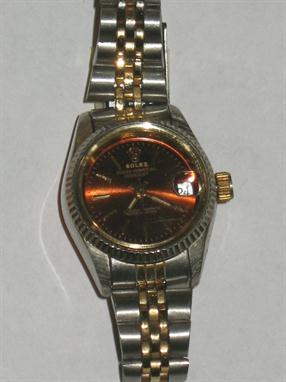An early Victorian rosewood dial timepiece with 8 inch dial. Carter, London, mid 19th century. The four pillar single chain fusee movement with large platform lever escapement with monometallic balance and jewelled pallets, the 8 inch circular silvered brass Roman numeral dial with recessed subsidiary seconds dial and signed CARTER, 61 Cornhill, London to centre and blued steel Breguet style moon hands within cast brass glazed bezel with canted silver surround to inner edge, the circular rosewood case with egg-and-dart moulded surround and brass hanging eye, 29.5cm (11.75ins) diameter. John Carter is recorded in Baillie G.H. Watchmakers & Clockmakers of the World as apprenticed in 1817 and gaining his freedom of the Clockmakers’ Company in 1829. He was an accomplished chronometer maker who won numerous awards at the 1838 chronometer trials; by 1840 he had set up business in 61 Cornhill. In 1855 Carter and held the position of jurer at the Imperial Exhibition held in Paris and was appointed Master of the Worshipful Company of Clockmakers three times (in 1856, 59, and 64). As well as being a highly skilled horologist John Carter was also notable as a civic activist -perhaps due to his experiences as a child as he was orphaned at an early age. His charitable nature lead him to be elected Lord Mayor in 1859, he died 1878.
11381 Preisdatenbank Los(e) gefunden, die Ihrer Suche entsprechen
11381 Lose gefunden, die zu Ihrer Suche passen. Abonnieren Sie die Preisdatenbank, um sofortigen Zugriff auf alle Dienstleistungen der Preisdatenbank zu haben.
Preisdatenbank abonnieren- Liste
- Galerie
-
11381 Los(e)/Seite
An early Victorian small ebonised mantel timepiece. Barraud and Lunds, London, circa 1840. The four pillar single fusee movement with anchor escapement and 4.5 x 4 inch rectangular silvered brass Roman numeral dial signed Barraud & Lunds, Cornhill, London, 2312 to centre, the spandrels engraved with delicate foliate scrolls and with blued steel hands, the case with triangular pediment and cavetto cornice above angled silvered brass fillet inset glazed front door and ogee outline waist moulding, on skirt base with pad feet, 26cm (10.25ins) high. Paul Philip Barraud is recorded in Baillie, G.H. Watchmakers & Clockmakers of the World as becoming a Liveryman of the Clockmakers’ Company in 1796 and appointed Master in 1810. He is listed as a fine watch and chronometer maker who worked in partnership with W. Howells and G. Jamisen for making Mudge’s timekeepers. He had two sons; Frederick Joseph (worked 1806-25) and John (worked from 1813), with whom he formed a partnership in 1811 which lasted until his death in 1820. The firm was continued by his son taking John Richard Lund into partnership in 1838. The business was finally wound up in 1925.
A mahogany domestic longcase regulator. Barraud, London, early 19th century and later, the case circa 1760. The five pillar movement now with deadbeat escapement, Harrison’s maintaining power, wood-rod pendulum and striking the hours on a gong, the 12 inch cream painted Roman numeral break-arch dial with subsidiary seconds dial to centre, STRIKE/ONE/SILENT selection lever at 12 o’clock and with gilt floral spray painted decoration to spandrels beneath arch signed BARRAUD, London, now in a break-arch case with foliate scroll pierced blind fret to frieze and brass stop-fluted Corinthian pilasters to hood above break-arch door to trunk, on plinth base with moulded double skirt, 230cm (90.5ins) high. Paul Philip Barraud is recorded in Baillie, G.H. Watchmakers & Clockmakers of the World as becoming a Liveryman of the Clockmakers’ Company in 1796 and appointed Master in 1810. He is listed as a fine watch and chronometer maker who worked in partnership with W. Howells and G. Jamisen for making Mudge’s timepkeepers. He had two sons; Frederick Joseph (worked 1806-25) and John (worked from 1813), with whom he formed a partnership in 1811 which lasted until his death in 1820. The firm was continued by his son taking John Richard Lund into partnership in 1838. The business was finally wound up in 1925. The going train of the current lot was upgraded from a relatively standard eight-day longcase movement to regulator specification and the strike train converted from bell striking to gong striking during the mid to late 19th century. The dial has been expertly re-touched however images of the dial prior to restoration are included with the clock, and serve to suggest that the Barraud name is original to the dial. The case is a good early George III London-made mahogany example in sound condition.
A Rolex 18ct gold gentleman’s automatic oyster perpetual wrist watch with white dial, gold batons and Roman numeral markers, inscribed Superlative Chronometer Officially Certified, Rolex crown at 12.0`clock, on original tapering bark textured bracelet with fold over clasp, supplied with green Rolex box, no papers
1950s / 1960s gentlemen's Longines Flagship Chronometer wristwatch with circular dial, gold hands and dart baton numerals and subsidiary seconds, in stainless steel case and a Breitling Chronometer wristwatch with black circular dial with red centre seconds and two further subsidiary dials, in chromium plated case, numbered on reverse - 550573 178, approximately 35mm diameter excluding winding crown (2)
A heavy, quality brass chronometer. With painted dial, graduated in half-minutes, marked’ Howden Airship Base 1922-23’, with small second hand, no dial, and fast/slow adjustment, with key. Thick glass to hinged bezel, on two feet with carrying handle. Diameter of case 14.5cm. Good working order and condition. Plate.16
ROLEX COMEX SUBMARINER. RÉF. 16800 VERS 1981 Montre bracelet de plongée en acier. Cadran noir mat avec index cerclés patinés, inscrit « Oyster Perpetual date, Comex, Submariner, 1000 ft = 300m, Superlative Chronometer Officialy Certified». Seconde centrale et guichet dateur à 3h. Lunette noire unidirectionnelle, graduée pour les temps de décompression. Verre saphir. Mouvement automatique, cal. 3035. Couronne et fond vissés. Fond gravé : « ROLEX - 6079 – COMEX ». L’intérieur du fond de boîte porte le même numéro de série qu’entre les cornes. Bracelet Rolex Oyster en acier avec boucle déployante. Cadran, boîtier et mouvement signés. Numérotée 7276743. Ecrin, certificat, un maillon supplémentaire et révision Bianchi du 6-01-2010. Diam. 39 mm La réf. 16800 est un modèle de transition qui inaugure les premières Submariner avec index cerclés et verre saphir mais qui peut conserver, comme ici, le cadran mat des anciens modèles (existe aussi avec cadran brillant). Elle a été produite de 1980 à 1986 à environ 200 exemplaires.
Gold shell Rolex Oyster Perpetual Date superlative chronometer, 1986, silvered satin dial, baton numerals, centre seconds, date at 3 o`clock, screw down crown, case36mm overall, numbered 15505 / 9333370, on rolled gold Oyster bracelet (ticks, winds adjusts date and time; Rolex service 2001, original guarantee 1986 and booklet) *See clocks and watches proviso.
Thomas Mercer, St Albans, a mahogany cased two-day chronometer, the chain-fusee movement having maintaining power, an Earnshaw-type detent escapement with the cut bimetallic compensated balance having round shaped weights, the four-inch silvered dial engraved with black Roman numerals, subsidiary seconds dial, ‘up-and-down’ dial for 56 hours, Admiralty mark and signed ‘Thomas Mercer, St Albans, England, 16442’, with blued steel spade hands, the serial number repeated to the bowl, with a plain two-tier mahogany case, diameter 18cm x 18cm x 17cm. The serial number on this movement would indicate a date of manufacture of 1943.* Thomas Mercer moved to London from Lancashire where he had worked with the famed chronometer maker Thomas Russell. Finding work hard to come by he was ready to emigrate to America. He had bought a one-way ticket, until he noticed a fine chronometer in the shop window of John Fletcher. He walked in and was immediately given a position as a watch springer and finisher. He then established his own business in 1858 at New North Road, London before, in 1874, moving to St. Albans, setting up a factory behind his house in Prospect Road. In September 1900 Thomas Mercer was appointed as judge for the horological class at the Universal Exhibition held in Paris. Unfortunately he caught a cold on the ferry crossing over and died at the Hôtel Internationale, Paris, whereupon his son Frank took over the running of the business. A 1929 Advert in the British Industries Fair Catalogue shows Mercers as manufacturers of the ‘Octo’ timekeeper System of Electric Synchronised Clocks for all purposes, both Land and Marine. The company closed in 1984.
An Omega Electronic steel circular cased calendar gentleman`s wristwatch, the signed circular silvered dial with raised black baton numerals, with a day-of-the-week and a date-of-the-month aperture, the dial detailed `Omega Electronic F300Hz Chronometer`, the steel bracelet with an Omega fold-over clasp.
LADY`S ROLEX OYSTER PERPETUAL DATE JUST OFFICIALLY CERTIFIED SUPERLATIVE CHRONOMETER, with mechanical movement, silvered circular dial with eleven diamond set batons, date aperture and sweep seconds hand, 18ct gold case, the bessel set with 32 diamonds and 4 rubies, 18ct gold Rolex strap, numbered 8560F, the watch back numbered 69068 EST 4000-5000
A gentleman`s stainless steel `Rolex Oyster Perpetual Superlative` chronometer wristwatch, the blue dial with batons, No. 1002, attached oyster bracelet No. 78350 with documents and boxesWE DO NOT STATE CONDTION IN THE ABOVE DESCRIPTION – Before bidding please ensure you are satisfied with the condition of this lot – For details of condition please contact the auctioneer.
A gentleman`s 18ct. gold full hunter pocket watch, Chester 1902, the white enamel dial with black Roman numerals `Talbot & Son - London`, the gilt keyless movement signed `Talbot & Son - Chronometer Makers, London No. 16355`, the 18ct. gold case with stop/start button, engraved monogram to outer back, hallmarked Chester 1902, weight 163 gms.WE DO NOT STATE CONDTION IN THE ABOVE DESCRIPTION – Before bidding please ensure you are satisfied with the condition of this lot – For details of condition please contact the auctioneer.
Early twentieth century military chronometer / deck watch box, the mahogany box of rectangular form, inset with an ivory disc inscribed Ollivant & Botsford with broad arrow mark HW 30696, the interior hinged and with label 'Issued from Royal Observatory, Greenwich', dated 19th September 1917, 11.5cm x 9cm
Gent`s 18K TITUS 17-jewel wristwatch with strapGent`s TITUS 17-jewel chronometer wristwatch with strap; in 18K (stamped ``750``, ``18K``) yellow gold. Round gold color double-sunk dial with Arabic numeral chapter stations and gold hands. The watch weighs 40.4 grams (with strap) and is 9`` long. (Condition: not working)Start Price: $200
A 1970`s steel Omega Constellation Chronometer; the battery operated watch with matt off white dial - marked Constellation Automatic Omega Electronic F300HZ and with date aperture - red seconds hand and unusual enamelled red and steel Omega symbol set in the 12th hour. The watch with luminous hands and original bracelet.
Russian Two-Day Marine Chronometer, c. 1955 Manufacturer: Moscow chronometer factory "Imeni Kirova", serial no. 8459, three-tier mahogany case with brass fittings, in outer mahogany case, with 2nd dial and up-and-down dial calibrated for 56 hours. - Running. Russischer Schiffs-Chronometer, um 1955 Hersteller: Moskauer Chronometerfabrik "Imeni Kirova", Serien-Nr. 8459, dreiteiliger Mahagoni-Kasten mit Messingbeschlägen, in Mahagoni-Transportkasten, Zifferblatt Ø 11 cm, mit Sekundenzeiger für 1/2 Sekunden und Gangreserve-Anzeige für 56 Stunden. - Voll funktionsfähig. Condition: (2/1-2) Starting Price: €450
-
11381 Los(e)/Seite



























































